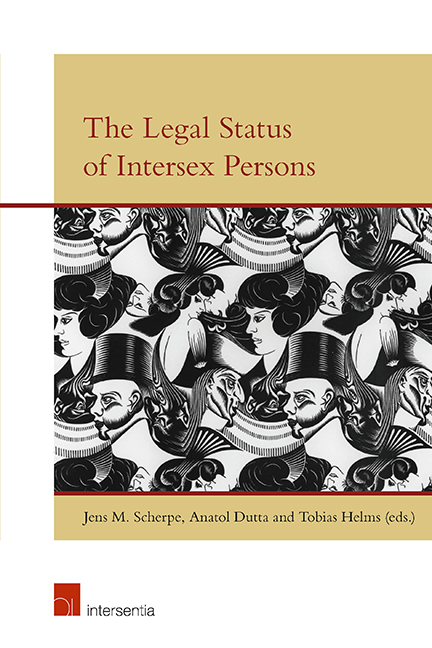Book contents
- Frontmatter
- Preface
- Contents
- List of Contributors
- The Legal Status of Intersex Persons: An Introduction
- Malta Declaration
- Darlington Statement
- Vienna Statement
- PART I MEDICINE AND PSYCHOLOGY
- PART II THEOLOGY AND LEGAL HISTORY
- PART III TRANSGENDER, TRANSSEXUALITY AND INTERSEX
- PART IV NATIONAL LEGAL DEVELOPMENTS
- PART V PRIVATE INTERNATIONAL LAW ASPECTS OF INTERSEX
- PART VI INTERSEX AND HUMAN RIGHTS
Darlington Statement
Published online by Cambridge University Press: 31 January 2019
- Frontmatter
- Preface
- Contents
- List of Contributors
- The Legal Status of Intersex Persons: An Introduction
- Malta Declaration
- Darlington Statement
- Vienna Statement
- PART I MEDICINE AND PSYCHOLOGY
- PART II THEOLOGY AND LEGAL HISTORY
- PART III TRANSGENDER, TRANSSEXUALITY AND INTERSEX
- PART IV NATIONAL LEGAL DEVELOPMENTS
- PART V PRIVATE INTERNATIONAL LAW ASPECTS OF INTERSEX
- PART VI INTERSEX AND HUMAN RIGHTS
Summary
Joint statement by Australia and Aotearoa/New Zealand intersex community organisations and independent advocates, including the Androgen Insensitivity Support Syndrome Support Group Australia (AISSGA), Intersex Trust Aotearoa New Zealand (ITANZ), Organisation Intersex International Australia (OIIAU), Eve Black, Kylie Bond (AISSGA), Tony Briff a (OIIAU/AISSGA), Morgan Carpenter (OIIAU/Intersex Day Project 4), Candice Cody (OIIAU), Alex David (OIIAU), Betsy Driver (Bodies Like Ours), Carolyn Hannaford (AISSGA), Eileen Harlow, Bonnie Hart (AISSGA), Phoebe Hart (AISSGA), Delia Leckey (ITANZ), Steph Lum (OIIAU), Mani Bruce Mitchell (ITANZ), Elise Nyhuis (AISSGA), Bronwyn O ‘Callaghan, Sandra Perrin (AISSGA), Cody Smith (Tranz Australia), Trace Williams (AISSGA), Imogen Yang (Bladder Exstrophy Epispadias Cloacal Exstrophy Hypospadias Australian Community – BEECHAC 5), Georgie Yovanovic.
Preamble
A. Intersex people are born with physical or biological sex characteristics (such as sexual anatomy, reproductive organs, hormonal patterns and/or chromosomal patterns) that are more diverse than stereotypical definitions for male or female bodies. For some people these traits are apparent prenatally or at birth, while for others they emerge later in life, often at puberty (see UN definition 6). We recognise our diverse histories and use the word intersex inclusively, and acknowledging our right to self-determination.
B. We observe that, despite the best efforts of intersex human rights defenders, discrimination, stigmatisation and human rights violations, including harmful practices in medical settings, continue to occur in Australia and Aotearoa/New Zealand.
C. We observe the 2013 Senate Community Affairs References Committee report, Involuntary or coerced sterilisation of intersex people in Australia, and the 2016 Family Court of Australia case, Re Carla (Medical procedure). We observe the Concluding observations on the fifth periodic report of New Zealand by the UN Committee on the Rights of the Child in 2016. 9
D. We recognise the international obligations of our countries, having signed the Convention against Torture, the Convention on the Rights of the Child, the Convention on the Elimination of Discrimination against Women, and the Convention on the Rights of Persons with Disabilities.
- Type
- Chapter
- Information
- The Legal Status of Intersex Persons , pp. 11 - 18Publisher: IntersentiaPrint publication year: 2018
- 1
- Cited by

